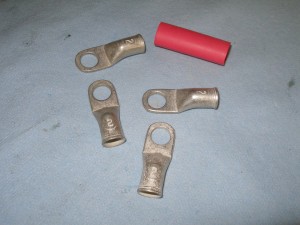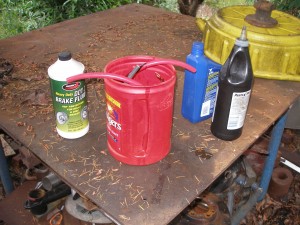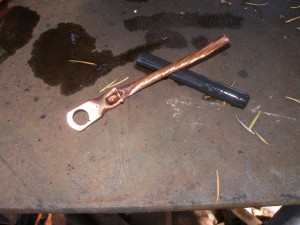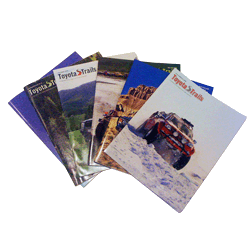By Tony K
Simple but important components of our rigs. They are the connection between the batteries and the starter and other larger high draw components such as winches. You can use the most basic battery cables you can find or get a little more picky and install some better cables.
-Types of Wire-
No matter the type of wire you use they all have the same core, copper wire. Differences include the strand count, how its woven inside, cost etc., but the biggest difference seems to be the insulation material. So for me the main things to consider are:
Flexibility – Determines just how easy it will be to do your wire runs. Flexibility of the wire is determined by the type and composition of the insulation. The number of strands in the core also has an effect on this.
Resistance to oil, grease and fuel – Really important under the hood of our wagons. Some insulation is better than others.
Resistance to damage from vibration – A high strand count in the wire resists vibration much better.
Cost and availability – Not my main concern but still important
Temperature rating – It shouldn’t be too low for obvious reasons
-Typical Battery Cables-
Plain old generic battery cables work just fine. Most makers use an SAE standard, J1127 (this is the most current one that I know of) It is what the auto manufacturers use as well. I would like to know exactly what this standard is but after going to the SAE website I found that you have to buy the information and I wasn’t that interested. So for now I just have to trust that any cable made to SAE standards is fit for it’s intended use.
Most battery wire I have looked at uses PVC for the insulation. The formula used is flexible enough for the intended use, resistant to oil, fuels and heat. Heat being important as it’s not exactly cool under the hood of a running rig, even one at idle all day in the woods.
I think the biggest benefit to regular battery cable is cost. Probably the cheapest option out there.
-Welding Cable-
Another option I frequently hear mentioned is welding cable. While it is perfectly capable of handling the voltage and amps that run through our systems, it has a major drawback. The insulation used for most welding cable does not do well around fuels and oil. But this is not the fault of the manufacturer. Welding cable is intended for a very different use than being installed under the hood. It is meant to be dragged around a jobsite and when it does get oil or chemicals on it, hopefully it will be wiped off. In some welding cable the core is even woven like rope ( I believe it is called class K Rope lay stranding).
To do what it’s designed to do welding cable is most commonly covered with Ethylene Propylene Diene Monomer, better known as EPDM rubber . It needs to be flexible and durable. While this is perfectly acceptable for it’s intended use not so under the hood. When welding cable is exposed to oil, fuel and grease, the insulation soaks it up. And once the muk is absorbed it doesn’t easily give it up.
And lest you think that cable rated as oil resistant is OK, think again. In a backyard test I did “oil resistant” welding cable was visibly swollen in less than 24 hours after soaking in a mixture of oil and fuel. Two days later I could remove the insulation by hand on a short piece that had the open ends down in the mix I had them soaking in. Oil resistant is not oil proof…
-Marine rated wire-
So what exactly is marine rated wire? Marine wire is basically the same as normal battery cable with a few notable differences. The type I use even has similar PVC as the insulation. But the similarities stop there. Differences are primarily on the inside. And marine wire is made to a different standard than automotive wire as the needs inside a boat or different than a our wagons. The standard listed by the ABYC is UL 1428. The American Boat and Yacht Council sets many of the standards for new boat manufacturers. And once again you have to buy the standard. Odd that regulating bodies don’t freely publish standards…
While our rigs are not exactly boats, marine wire has a lot of properties that are desirable for an off road rig. The vibration resistance and flexibility are high on my list and it is also generally made to very high standards.
Marine wire is coated for corrosion resistance. While this may be debated in the marine circles as to it’s usefulness, it does mean that each individual strand is coated with tin. Which is why it appears to be silver wire when you strip the insulation. Typically has a higher temperature rating than regular battery cables too.
The external difference is the fact that marine wire must be marked on the outside with type/style, voltage, wire size and temp rating/dry. There is no such requirement in the automotive industry. Just try finding this info for regular battery cables.
The most notable difference is the strand count, going from around 130 strands in a typical 2 awg battery wire to 665 strands in a 2awg type 3 rated marine wire. The reason for the difference once again comes down to intended use. A high strand count translates to better flexiblilty and vibration resistance, something the marine industry considers important. Interestingly enough welding cable generally has an almost indentical strand count to type 3 marine wire.
 -Connections-
-Connections-
Wire isn’t much good if it’s not connected to anything. My preferred choice is to use crimp connections. Once again tinned copper is the material of choice. Crimping is much easier to do than soldering and they have better vibration resistance than a soldered connection. Large connectors are always double crimped to make sure they do not come loose. I also use heat shrink tubing once the crimps are done. Heat shrink keeps a lot of moisture and other crude out of the wire ends. Good heat shrink tubing actually has glue on the inside to seal the connection as it shrinks up tight.
Funny how the marine industry considers vibration resistance of key importance so they don’t allow solder connections as primary mechanical connection while according to a SAE mechanic I know the auto repair industry prefers solder connections….
Unfortunately the crimp tools are expensive if you are not going to do a lot of this. The crimpers look more like bolt cutters than the small crimp tools most of us have in our toolboxes. Lucky for me I have access to the tools through my work.
 -Oil, Fuel and Backyard Science-
-Oil, Fuel and Backyard Science-
I had heard about what oil and fuel will do to welding cable but I wanted to see it with my own eyes. Came up with a little test to see exactly what would happen. I dumped a little bit of just about every fluid our rigs could leak into a bucket and added a few chunks of battery and welding cable into the mix.
I wasn’t so much interested in the exact cause of cable degradation but more of what actually happens. So the easiest way to see what happens was to create a worst case scenario. Motor oil, gasoline, diesel, brake fluid, ATF, you name it, it went in the bucket.
My wire samples included some loops of wire where the only part exposed to the fluid was the insulation and some short chunks that had ends submerged so the fluid penetrated the core.
The wire I tried was Ancor Marine Wire and some welding wire I had that is marked Royal/Excelene. I looked through my junk heap but couldn’t find any factory Toyota cables or even some generic battery cables so my test was somewhat limited.
24 hours later- No surprise that the marine wire showed nothing. While the welding wire already had visible signs of swelling
 48 hours – Still no effect on the marine wire. Welding cable had swelled even more and the insulation of the short piece submerged in the mix could literally be pulled off with very little effort.
48 hours – Still no effect on the marine wire. Welding cable had swelled even more and the insulation of the short piece submerged in the mix could literally be pulled off with very little effort.
Just started on day 3 so there will be more to this story. Be interesting to see how the welding cable reacts to being removed from the mix. Will it dry or continue to degrade. Might be interesting to see what happens to the oil soaked wire when large amounts of current are run throught it or maybe not…
-Trial by Fire-
Just for the heck of it put some samples to the flame. Used my propane torch to try and burn up the insulation. Got a bit of a surprise with this one. Everything I have read about PVC says it won’t support combustion, meaning remove the heat source and the flame will go out. While this did turn out to be mostly true PVC insulation will melt and deform. Also the flame did seem to burn off components of the plastic and what remained was way thinner than the original insulation. It also was no longer was tight around the wire, still intact but it had expanded.
Now for the surprise part. Everyone who has burned things they shouldn’t, knows rubber will burn. This also held true for the EPDM insulation but it did go out on its own, just took longer than the PVC to go out. But unlike the PVC, what was burning on the welding cable insulation was only the exterior surface. After it had cooled off a quick look showed very little change to the insulation other than surface charring. For the most part the insulation was intact and still doing it’s job.
Did not expect this result. Think I might need to look further into this….
-Final Opinions-
The stock battery cables work just fine. It is when you start changing things that you need to make a decision about which wire type to use. I use marine wire for almost everything. I have ready access to it and it’s just a good solid product.
There is an extremely limited amount of welding cable under my hood and it is only to power my Readywelder. If you do use welding cable it should only be used in an area where the wire will not see any type of oil or fuel.
As for other options, there may be some out there that I am as yet unaware of. Technology is changing all the time.

